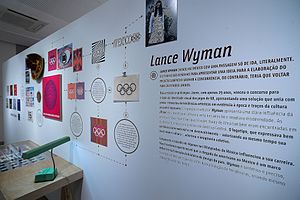Lance Wyman
Lance Wyman | |
|---|---|
 | |
| Born | 1937 (age 86–87) Newark, New Jersey, United States |
| Occupation | Graphic designer |
Lance Wyman (born 1937)[1] is an American graphic designer known for his work under Pedro Ramirez Vazquez, design concept and direction in developing applications of the logo for the 1968 Summer Olympics in Ramirez Vazquez's personal office in Mexico City.
Life and career[edit]
Wyman, the son of a commercial fisherman and a typist,[2] grew up in Kearny, New Jersey, where he worked in the factories during summers to pay for college. He acquired an appreciation for the "no-nonsense functional aesthetic of the sea and the factories", which he has described as "an important influence in my approach to design."[1] He graduated from the Pratt Institute with a degree in industrial design in 1960. The subject of graphic design was just being introduced in American universities at the time; when Wyman met a student who studied logo design with Paul Rand at Yale, he wanted to design logos.[1]
Wyman began his career at General Motors in Detroit, Michigan, where he worked on a packaging system for Delco automotive parts that unified 1,200 different packages. Later, he moved to the office of William Schmidt, where he produced the graphics for the U.S. pavilion at a 1962 trade fair in Zagreb, Yugoslavia.[1]
In 1963, Wyman moved to New York, where he joined the George Nelson firm. He designed the graphics for the Chrysler Pavilion at the New York World's Fair. He later reported that devising a "pointing hand" themed logo and adapting it to the site directional signs convinced him that logos could play a more important role in an overall design program.[1] In December 1966, he traveled to Mexico City to work at Pedro Ramirez Vazquez's office, and worked with many other designers in the identity program of the 1968 Summer Olympic Games. Wyman stopped working for the organizing committee in October 1968, he then designed the graphics programs for the Mexico City Metro.
After returning to New York, Wyman formed a partnership with Bill Cannan (Wyman & Cannan). In 1979, he established his own firm, Lance Wyman Ltd. He has also taught corporate and wayfinding design at Parsons School of Design since 1973.[1]
Work[edit]

Wyman, who has been described as a "rock star" of graphic arts,[2] made his reputation when he collaborated with Eduardo Terrazas, under the direction of architect Pedro Ramírez Vázquez, in the development of the entire design campaign for the Mexico 1968 Summer Olympic Games. He has also designed icons for museums and many other institutions, individualized signs for buildings at the National Zoo in Washington D.C., and many other symbols. Stepping outside his usual genre, he designed a poster for the 2008 Barack Obama presidential campaign.[3] Perhaps his most enduring design is the stylized route map he devised for the Washington Metro in the mid-1970s, prioritizing the clear representation of routes, stations, transfer points, and certain landmarks over showing distances to scale.[2] In 2011, Wyman was called on to design a new Metro map depicting new lines and route orientations, as well as some station names that had been expanded to the point of being cumbersome.[4][5] It was one of the few occasions in which the original designer has had a chance to revise his own creation.[2] The new map debuted March 19, 2012,[6] and an update was announced on September 12, 2013.[7] Wyman suggested naming the then-under-construction Metro line the Cherry Blossom Line, but it became the Silver Line instead.[8]
Wyman's work was the subject of a retrospective exhibition called "Urban Icons" at El Museo Universitario Arte Contemporáneo (MUAC) in Mexico City (2014–15).[9] In 2017, he was awarded the AIGA Medal for his "mastery of visual ecosystems and for setting the standard for the universal, public design experience."[10]
References[edit]
- ^ a b c d e f Case Study: Lance Wyman, WebEsteem Art & Design Magazine, 2004
- ^ a b c d Dana Hedgpeth, "After more than 30 years, Metro map is being redesigned by creator Lance Wyman", washingtonpost.com, June 4, 2011; printed as "An icon's midlife facelift: Metro map must be updated, so its creator goes back to the drawing board", The Washington Post, June 5, 2011, p. A1.
- ^ Steven Heller (2010-10-04). "Wyman in Ireland". Print. Retrieved 2017-05-30.
- ^ Steve Delahoyde, Lance Wyman Difficult Task of Re-Designing His Original DC Metro Map, Mediabistro.com, Unbeige, June 6, 2011.
- ^ Dana Hedgpeth, "Metro's Main Designer", Express (Washington, D.C.), June 6, 2011, p. 12.
- ^ Dana Hedgpeth, "Metro debuts new map and service changes", The Washington Post, March 19, 2012.
- ^ Dana Hedgpeth, "A Familiar Direction", Express (Washington, D.C.), September 12, 2013, p. 13.
- ^ Vicky Hallett, "Did You Know?", Express (Washington, D.C.), July 28, 2014, p. 9.
- ^ Lance Wyman, MUAC Exhibition
- ^ "2017 AIGA Medalist Lance Wyman". AIGA | the professional association for design. Retrieved 2017-04-12.
